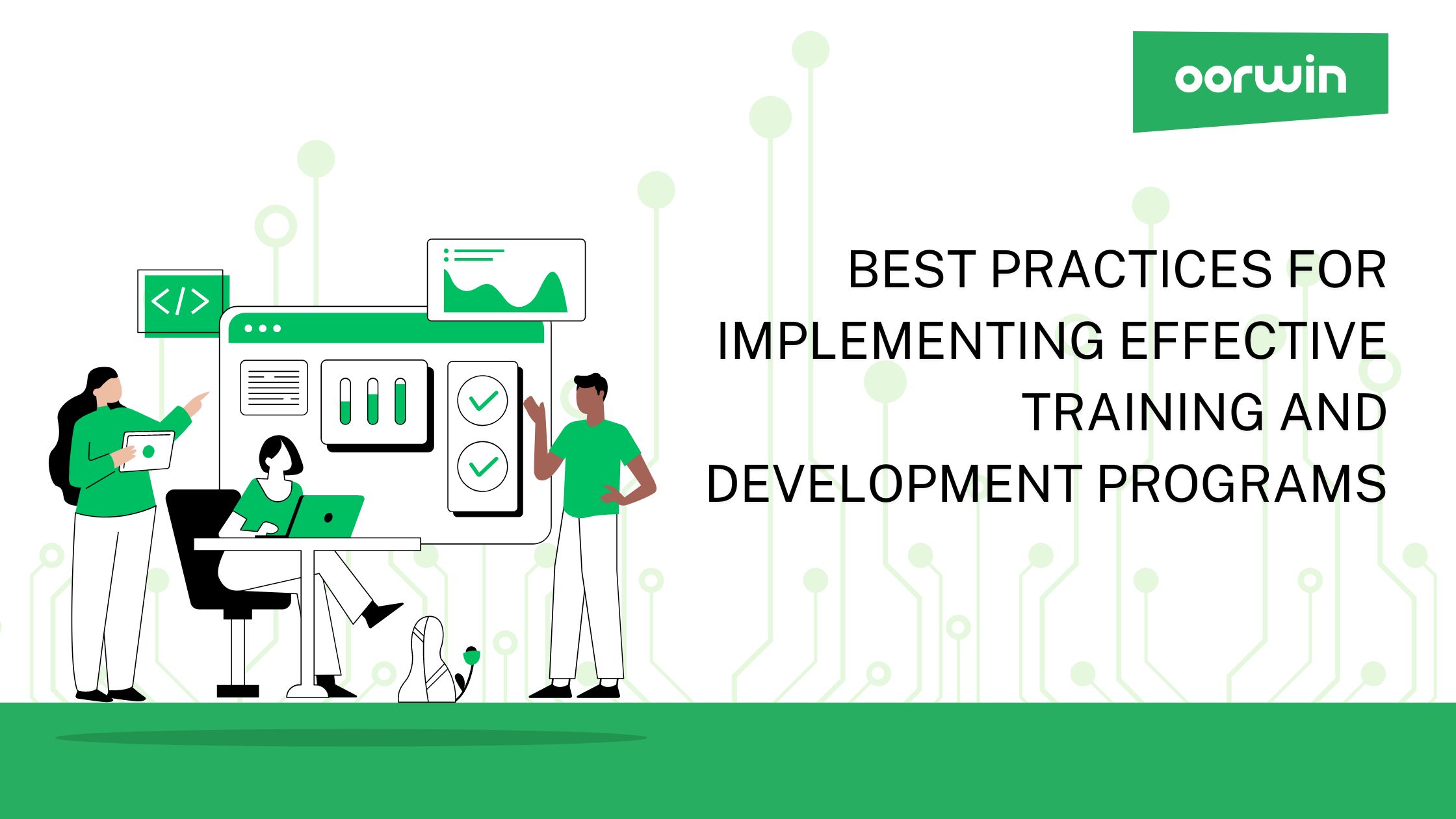Best Practices for Developing An Effective Training and Development Program
Oorwin
7min read / 23 Mar 2023

Related Articles
Best Practices for Training and Development
In today’s rapidly evolving business landscape, organizations realize the significance of investing in their most valuable asset: their employees. As competition intensifies and technological advancements reshape industries, training, and development have become paramount. Organizations prioritizing their workforce’s growth and development are better equipped to adapt, innovate, and thrive in this dynamic environment.
Practical training and development programs enhance employees’ knowledge and skills and contribute to positive work culture, increased employee engagement, and improved organizational performance. However, with the plethora of training options available and ever-changing learning methodologies, it can take time for businesses to determine the best practices that yield optimal results.
Training and development play a crucial role in the growth and success of any organization. Some of the best practices include:
4 Best Practices for Developing an EffectiveTraining and Development Program
Develop a system for transferring your employees’ knowledge
One of the best practices for training and development plans is to develop a system for transferring your employees’ knowledge. This means that organizations must create a process allowing employees to share their knowledge and expertise with their colleagues. It could be a knowledge management system or a mentoring program where employees can learn from each other’s experiences.
By developing an effective employee training program, organizations can promote a culture of learning and continuous improvement. It can also help employees to create a sense of ownership and responsibility toward their work. This practice can also help to retain valuable employees and prevent knowledge loss when employees leave the organization.
Implement a peer-to-peer feedback loop.
Another best practice for training and development is implementing a peer-to-peer feedback loop. This means that employees should provide feedback to their colleagues on their work performance, skills, and areas for improvement. This practice can help employees identify their strengths and weaknesses and develop the skills required for their job roles.
Feedback from colleagues can also be more valuable than feedback from supervisors, as colleagues better understand the day-to-day challenges and expectations of the job. Another potential outcome is establishing an environment that fosters transparency and openness, enabling staff members to feel at ease when expressing their opinions and concepts.
Customize your employees’ learning paths.
Every employee has different learning needs and preferences. Some employees learn better through hands-on experience, while others prefer classroom-style learning. Customizing learning paths to meet employees’ needs can be a best practice for training and development.
By offering personalized training and development programs, organizations can help employees to acquire new skills and knowledge more effectively. This can lead to better job performance, higher job satisfaction, and employee retention.
Ask your people what skills they want to develop.
One of the most effective ways to design a training and development program is to ask employees what skills they want to develop. This practice helps align the organization’s goals with employee aspirations. It can also create a sense of ownership and commitment among employees toward learning and development.
Asking employees about their development needs can help organizations identify skill gaps and develop programs addressing them. This can lead to a more skilled and capable workforce better equipped to meet the organization’s needs.
Effective Training Techniques
Apart from the best practices mentioned above, there are some ways to develop effective training programs that organizations can use to enhance employee learning and development. Some of these techniques include:
- Microlearning: Microlearning involves breaking down complex topics into small, bite-sized information that employees can easily absorb. This can make learning more engaging and increase knowledge retention.
- Gamification involves using game elements to make learning more engaging and fun. This can motivate employees to learn and increase their interest in training programs.
- Blended learning: Blended learning combines different learning methods, such as online learning, classroom-style learning, and hands-on training. This can cater to other learning preferences and enhance the effectiveness of training programs.
Learning and Development Strategies
Developing an effective learning and development strategy can help organizations to align their training programs with their business goals. A well-designed learning and development strategy should include the following key elements:
- Identify training needs: Organizations should identify the skills and knowledge gaps that need to be addressed through training and development programs.
- Develop training programs: Based on the identified training needs, organizations should develop training programs tailored to meet those needs. These programs should be designed to be engaging and interactive and include various learning methods.
- Evaluate training effectiveness: Organizations should regularly evaluate the effectiveness of their training programs. This can be done through employee feedback, assessments, and performance reviews.
- Continuous improvement: Based on the evaluation results, organizations should continuously improve their training programs to ensure they effectively meet their business goals.
- Value-Based Company Culture: L&D may support the development of a values-based culture and a feeling of community in organizations when the workforce is becoming more virtual and distributed globally. Employees are enthusiastic about working for ethical, environmentally friendly companies that advance societal well-being.
Employee Training Programs
Employee training programs are essential to any organization’s learning and development strategy. These programs can help employees to acquire new skills and knowledge, improve job performance, and increase job satisfaction. Some of the standard employee training programs include:
- Onboarding: Onboarding programs help new employees to acclimate to their new job roles and the organization’s culture. These programs can include orientation sessions, job shadowing, and mentorship programs.
- Leadership development: Leadership development programs help to prepare employees for leadership roles within the organization. These programs can include training in management, communication, and decision-making skills.
- Compliance training: Compliance training programs help employees to understand and adhere to regulatory requirements and company policies. These programs can include training on workplace safety, data privacy, and anti-discrimination laws.
Frequently Asked Questions
How do you implement an effective training program?
To implement an effective training program, organizations should identify training needs, develop tailored training programs, ensure employee participation, and evaluate the effectiveness of the programs.
What are the five fundamental principles of developing an effective training strategy?
The five fundamental principles in developing an effective training strategy are identifying training needs, aligning training with business goals, developing engaging training programs, evaluating training effectiveness, and continuous improvement.
What are the benefits of employee training and development?
Employee training and development can improve job performance, increase job satisfaction and retention rates, and create a more skilled and capable workforce. It can also help organizations to achieve their business goals and stay competitive in their industry.
Popular Articles..
Blog

2min read / 25-Jun-2025
Master Effective Interview Techniques with Oorwin: A Step-by-Step Recruiter’s Guide
Blog
Blog
Get the latest Oorwin releases, updates, success stories & industry news
 Back
Back
